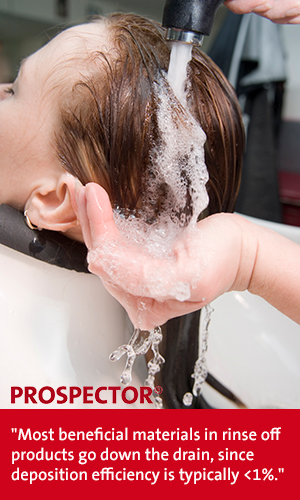 The deposition of beneficial materials from rinse off products is an important need when formulating shampoos, body washes, and hair conditioners. Beneficial materials include fragrances (EU), silicones (EU), solid particles, and other hydrophobic skin/hair conditioning ingredients. Most of these ingredients go down the drain since deposition efficiency is typically <1%. Deposition technologies can significantly increase this.
The deposition of beneficial materials from rinse off products is an important need when formulating shampoos, body washes, and hair conditioners. Beneficial materials include fragrances (EU), silicones (EU), solid particles, and other hydrophobic skin/hair conditioning ingredients. Most of these ingredients go down the drain since deposition efficiency is typically <1%. Deposition technologies can significantly increase this.
The main mechanisms that increase deposition are coacervation, precipitation and filtration. Coacervation occurs when anionic surfactant/cationic polymer complexes that are soluble in the product precipitate during product dilution or rinsing. Actives like lipids (EU) or fragrances become entrapped in the micelles that are part of the complex and co-precipitate. Filtration occurs when complexes or actives become physically trapped during product application and rinsing to substrates like hair.
Factors controlling coacervate precipitation and deposition:
Polymer molecular weight, cross-linking, charge density, and concentration
- Low molecular weight (MW) polymers (EU) tend to produce low amounts of coacervate regardless of charge density.
- Polymer hydrophobicity.
- High MW polymers form more coacervate than when using low MW polymers of the same charge density.
- For polymers of equal MW but different charge densities, the higher charge density polymer produces more coacervate.
Polymeric back bone type and branching
- Cationic guar (EU) (more flexible, branched) deposits better than cationic hydroxyethyl cellulose (EU) (stiff, non-branched) of similar molecular weight and charge density.
Surfactant
- Anionic surfactants (EU) perform the best. More highly charged anionic surfactants like sodium lauryl sulfate (EU) react and bind better with cationic polymer.
- Higher surfactant concentration increases the amount of dilution necessary to get coacervate precipitation.
- Gemini surfactants like sodium cocoyl glutamate (EU) are superior to single head group anionic surfactants.
- Amphoterics combined with anionics (EU) tend to increase the amount of dilution necessary to get coacervate precipitation.
Particles
- Solid-shape, particle size.
- At a comparable particle size, flat particles deposit onto the scalp better than spherical ones and 12-18 nm spherical particles deposit better than 3-5 micron spherical particles.
- Solid particle deposition from a shampoo base onto the scalp can be increased by polymers that enhance particle charge and modify foam rheology. In the absence of hair, particle deposition is very low due to less particle entrapment.
- Emollient (EU) polarity, molecular weight, concentration, and particle size.
- Small particle size silicone (.5 micron) deposits better using high MW polymer vs. low. For large particle size silicone (20 micron), lower MW polymer gives better deposition vs. high MW polymer.
- Large particle size silicones deposit well even without polymer but continued product use can lead to significant silicone buildup on hair.
- Hydrophobic emollients reduce the amount of dilution necessary for coacervate precipitation vs. polar emollients or no emollient.
Other factors
- Amount of dilution/rinsing during use.
- Coacervate rheology.
- Electrolyte in formulation-type and concentration.
- Electrolytes reduce the amount of coacervate and increase the dilution necessary to get precipitation.
- Lather amount and stability.
- Higher lather stability increases active deposition.
- PH
The views, opinions and technical analyses presented here are those of the author or advertiser, and are not necessarily those of ULProspector.com or UL Solutions. The appearance of this content in the UL Prospector Knowledge Center does not constitute an endorsement by UL Solutions or its affiliates.
All content is subject to copyright and may not be reproduced without prior authorization from UL Solutions or the content author.
The content has been made available for informational and educational purposes only. While the editors of this site may verify the accuracy of its content from time to time, we assume no responsibility for errors made by the author, editorial staff or any other contributor.
UL Solutions does not make any representations or warranties with respect to the accuracy, applicability, fitness or completeness of the content. UL Solutions does not warrant the performance, effectiveness or applicability of sites listed or linked to in any content.



Leave a Reply or Comment